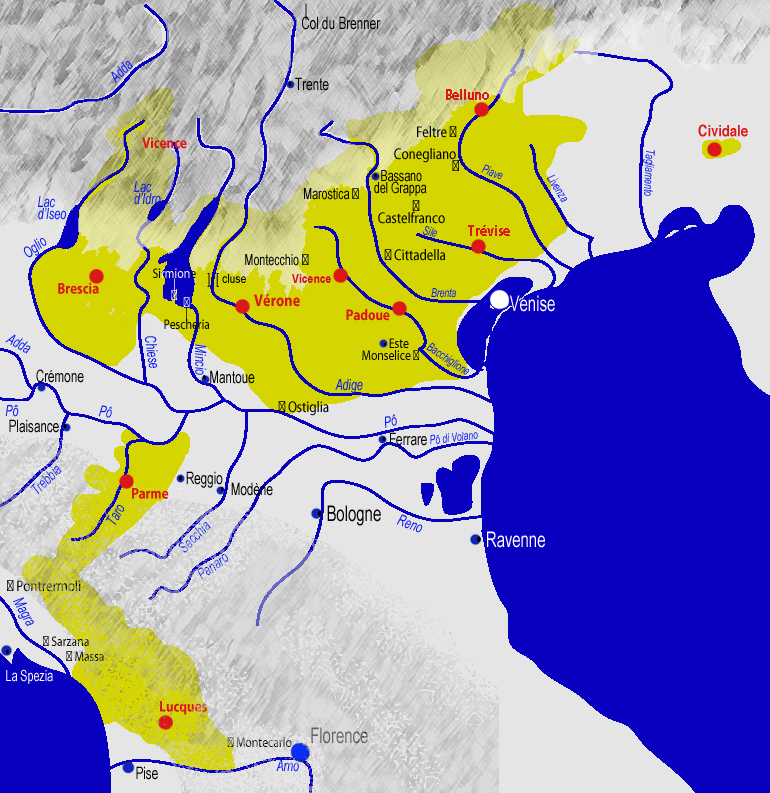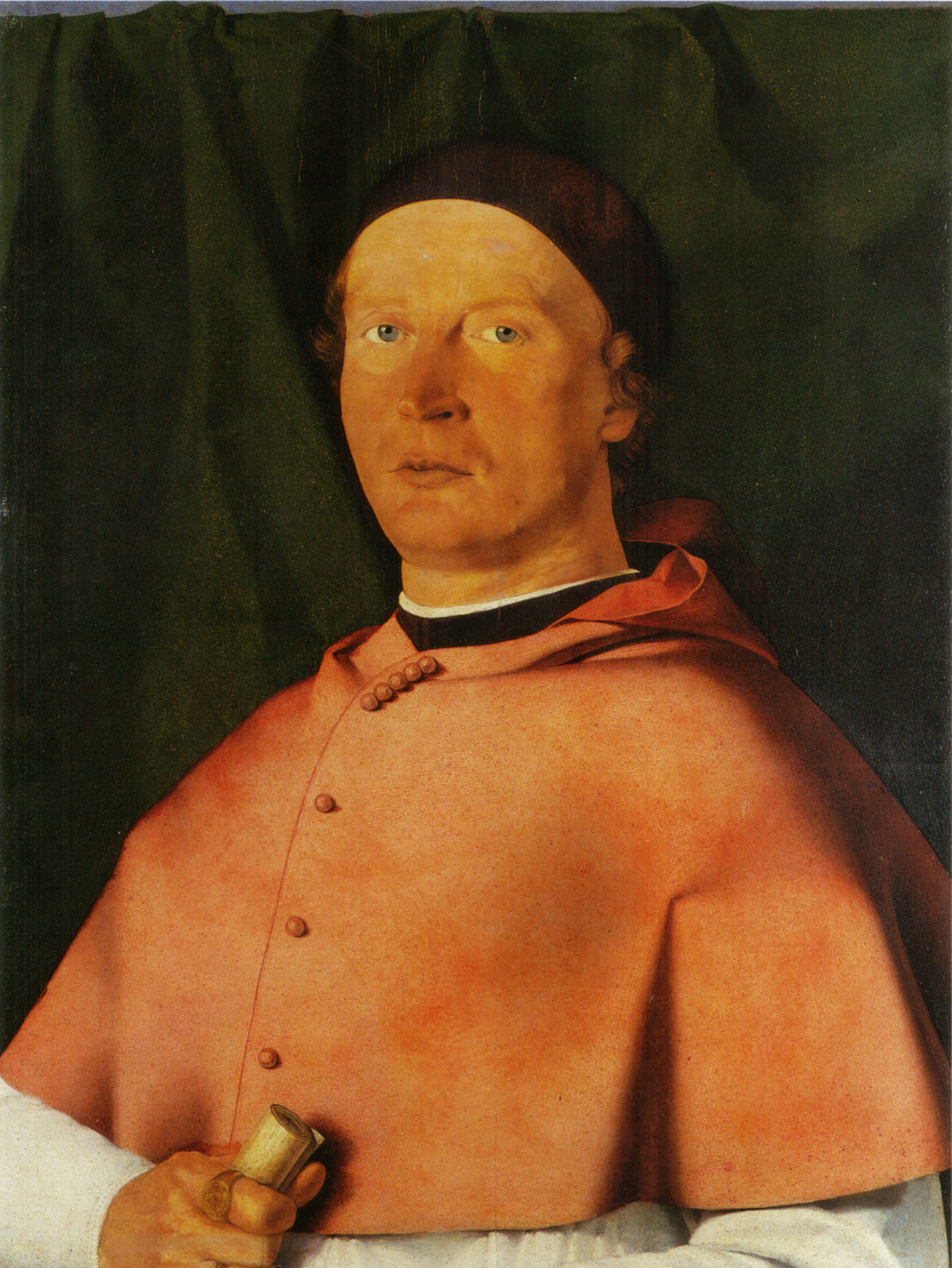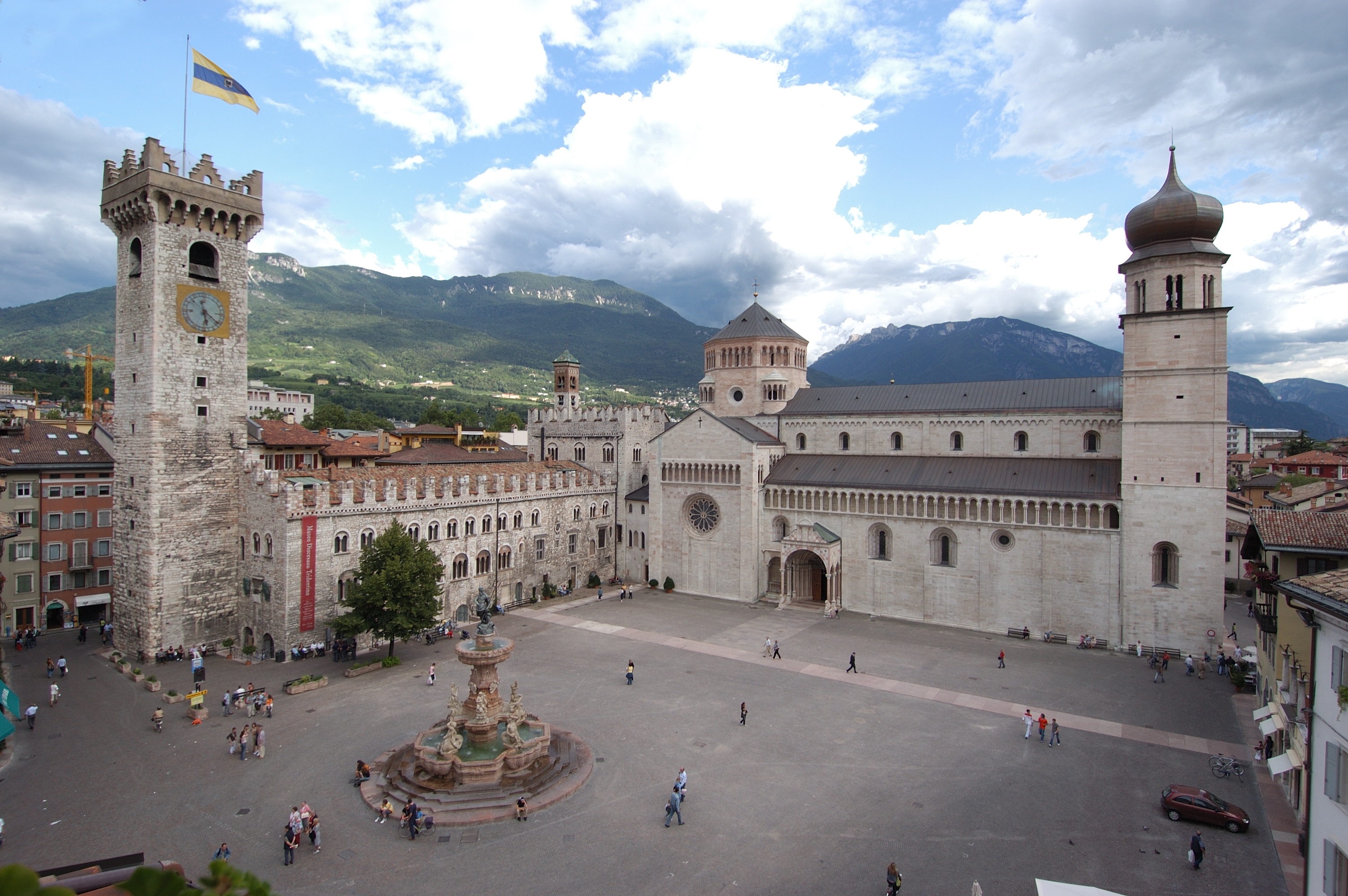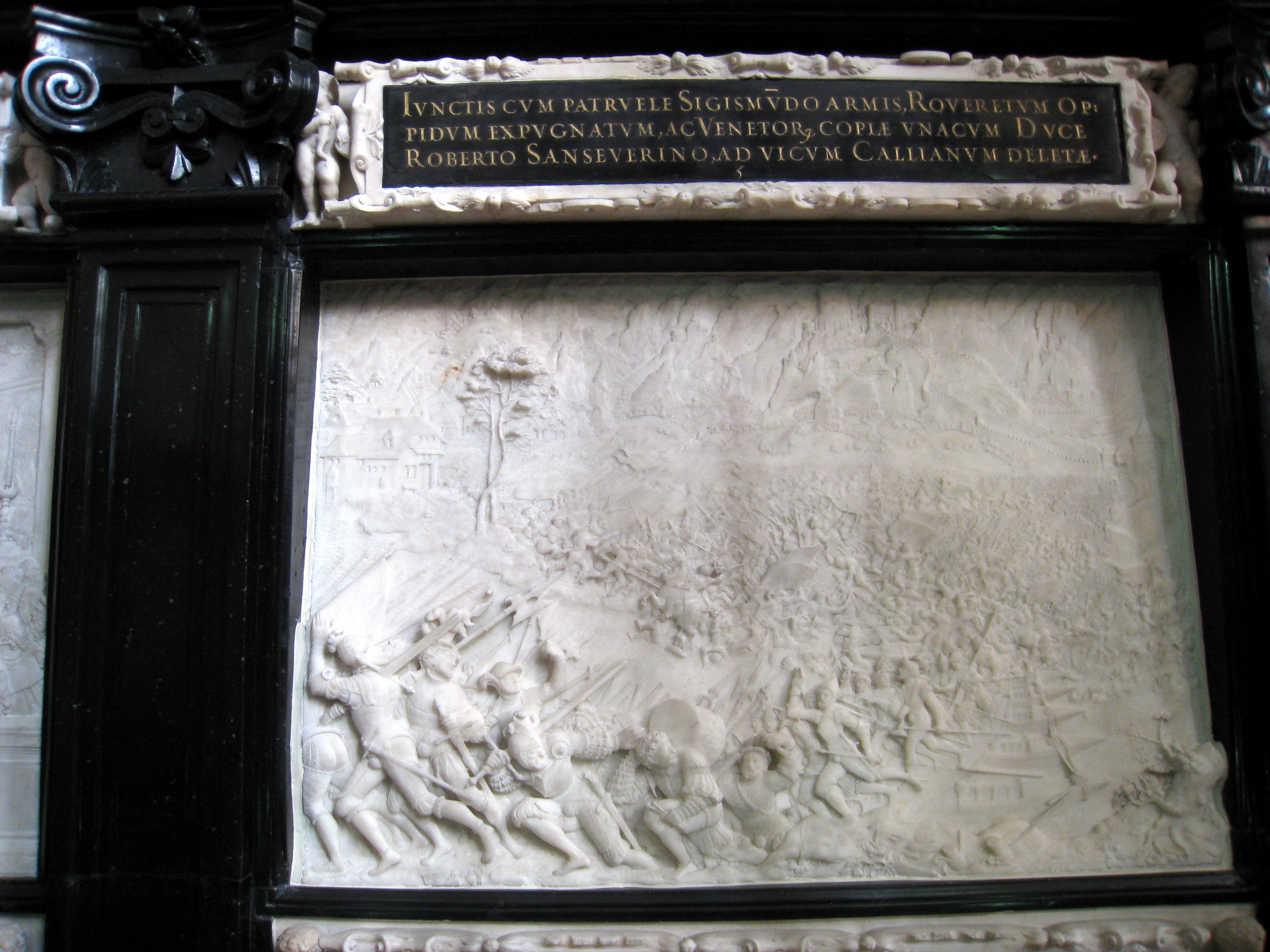|
Guido De' Rossi
Guido de' Rossi (c. 1440 - 1490) was an Italian condottiero. Life He was almost certainly born in the castle at San Secondo Parmense, San Secondo, the residence of his father Pier Maria II de' Rossi. His mother was Pier Maria II's wife Antonia Torelli. Little is known of his youth: he served in the duke of Milan's army and in 1478 was made governor of Pontremoli and Lunigiana. He is known to have been a condottiero and man-at-arms in 1479. Pompeo (1781-1851) Litta''Famiglie celebri di Italia. Rossi di Parma''/ P. Litta In his will in 1464 Pier Maria II made Guido, his brother Bertrando de' Rossi (1429), Bertrando and one of his illegitimate sons his heirs. This disinherited Pier Maria II's eldest son Giovanni de' Rossi, Giovanni. Guido came to his father's aid during the Rossi War against Ludovico il Moro and was thus declared a rebel by the duchy of Milan. He successfully held the Rocca dei Rossi in San Secondo against a Sforza siege under Antonio del Vasto (son of the marquess o ... [...More Info...] [...Related Items...] OR: [Wikipedia] [Google] [Baidu] |
Condottiero
Condottieri (; singular: ''condottiero'' or ''condottiere'') were Italian military leaders active during the Middle Ages and the early modern period. The term originally referred specifically to commanders of mercenary companies, derived from the Italian word ''condotta''—the contract under which they served a Italian city-states, city-state or lord. The word ''condottiero'' thus meant 'contractor'. Over time, however, in Italian usage, ''condottiero'' came to mean any 'commander' or 'military leader'. Mercenary captains Background In the 13th and 14th centuries, the Italian city-states of Republic of Venice, Venice, Republic of Florence, Florence, and republic of Genoa, Genoa were very rich from their trade with the Levant, yet possessed woefully small armies. In the event that foreign powers and envious neighbours attacked, the ruling nobles hired foreign mercenaries to fight for them. The military-service terms and conditions were stipulated in a (contract) between the city ... [...More Info...] [...Related Items...] OR: [Wikipedia] [Google] [Baidu] |
Nure
The Nure (Latin ''Nura'') is a small river in northern Italy (province of Piacenza). It has its source on the northern slopes of Mt. Nero, elevation above sea level, and after a course of about —the second longest of the province—flows into the Po River east of Piacenza, in the vicinity of Roncarolo, a ''frazione'' of the commune of Caorso, on the border with the Lombard commune of Caselle Landi. The upper valley is somewhat influenced by the sea air, keeping it free of fog and strong winds, and therefore relatively pleasant even during the winter months. In this valley, there are 79 fortification A fortification (also called a fort, fortress, fastness, or stronghold) is a military construction designed for the defense of territories in warfare, and is used to establish rule in a region during peacetime. The term is derived from Lati ...s (castles, fortified towers and dwellings, etc.) The main villages along this river are: Ferriere, Bosconure, Can ... [...More Info...] [...Related Items...] OR: [Wikipedia] [Google] [Baidu] |
Rossi Family (Parma)
The Rossi family is an Italian noble lineage originating from the Emilia region, now part of the province of Parma. Their history is well-documented in the archives of Parma and San Secondo. The earliest recorded mention of the Rossi family in Emilia dates back to 1323. History Origins In the 14th century, the Rossi family established a notable presence in the region, including Berceto and Terenzo, located at the foot of the Parma Apennines, within the episcopal patrimony. Their rise began when Ugolino Rossi, son of Guglielmo, was appointed Bishop of Parma in 1324 at the age of 23. He held this position until he died in 1377,Murdered in Milan according to the Rossi of Parma genealogy website. overseeing the mense and revenues from territories such as Berceto, Bardone, Corniglio, Bosco, Roccaprebalza, Roccaferrara, Corniana, and Castrignano, which became significant holdings for the Rossi family in the following century. This appointment gave the family a long-term posi ... [...More Info...] [...Related Items...] OR: [Wikipedia] [Google] [Baidu] |
15th-century Condottieri
The 15th century was the century which spans the Julian calendar dates from 1 January 1401 (represented by the Roman numerals MCDI) to 31 December 1500 (MD). In Europe, the 15th century includes parts of the Late Middle Ages, the Early Renaissance, and the early modern period. Many technological, social and cultural developments of the 15th century can in retrospect be seen as heralding the " European miracle" of the following centuries. The architectural perspective, and the modern fields which are known today as banking and accounting were founded in Italy. The Hundred Years' War ended with a decisive French victory over the English in the Battle of Castillon. Financial troubles in England following the conflict resulted in the Wars of the Roses, a series of dynastic wars for the throne of England. The conflicts ended with the defeat of Richard III by Henry VII at the Battle of Bosworth Field, establishing the Tudor dynasty in the later part of the century. Constant ... [...More Info...] [...Related Items...] OR: [Wikipedia] [Google] [Baidu] |
Bernardo De' Rossi
Bernardo de' Rossi (26 August 1468 – 28 June 1527) was an Italian bishop and patron of the arts. Biography Rossi was the son of a feudal family of the area of Parma, at a young age he received the archdeaconate of Padua and the Abbey of St. Crisogonus in Zadar. On 4 Apr 1487, thanks to the support of the Republic of Venice, he was appointed Bishop of Belluno. On 16 Aug 1499, he was appointed as bishop of Treviso. Here he held a small court, featuring artists such as Lorenzo Lotto, who painted a portrait of him around 1505. In 1503, de' Rossi entered into conflict with the Venetian podestà of Treviso, Girolamo Contarini. In September of that year a plot set against him by the Onigo family failed as it was discovered before its application. In 1509, after further controversies with the Venetian authorities, he was forced to leave the diocese, and moved to Rome (1510). In 1522 he returned to the ancestral field of San Secondo Parmense, fighting against members of h ... [...More Info...] [...Related Items...] OR: [Wikipedia] [Google] [Baidu] |
Gallerie Dell'Accademia
The Gallerie dell'Accademia is a museum gallery of pre-19th-century art in Venice, northern Italy. It is housed in the Scuola della Carità on the south bank of the Grand Canal, within the sestiere of Dorsoduro. It was originally the gallery of the Accademia di Belle Arti di Venezia, the art academy of Venice, from which it became independent in 1879, and for which the Ponte dell'Accademia and the Accademia boat landing station for the '' vaporetto'' water bus are named. The two institutions remained in the same building until 2004, when the art school moved to the Ospedale degli Incurabili. History Early history The Accademia di Belle Arti di Venezia was founded on 24 September 1750; the statute dates from 1756.Accademia di belle arti di Venezia, 1750–2010. Cenni storici (in Italian) ... [...More Info...] [...Related Items...] OR: [Wikipedia] [Google] [Baidu] |
Pietro Bembo
Pietro Bembo, (; 20 May 1470 – 18 January 1547) was a Venetian scholar, poet, and literary theory, literary theorist who also was a member of the Knights Hospitaller and a cardinal of the Catholic Church. As an intellectual of the Italian Renaissance (Quattrocento, 15th–Cinquecento, 16th c.), Pietro Bembo greatly influenced the development of the Tuscan dialect as a literary language for poetry and prose, which, by later codification into a standard language, became the modern Italian language. In the 16th century, Bembo's poetry, essays and books proved basic to reviving interest in the literary works of Petrarch. In the field of music, Bembo's literary writing techniques helped composers develop the techniques of musical composition that made the madrigal (music), madrigal the most important secular music of 16th-century Italy. Life Pietro Bembo was born on 20 May 1470 to an aristocratic Venetian Bembo (family), family. His father Bernardo Bembo (1433–1519) was a dip ... [...More Info...] [...Related Items...] OR: [Wikipedia] [Google] [Baidu] |
Trento
Trento ( or ; Ladin language, Ladin and ; ; ; ; ; ), also known in English as Trent, is a city on the Adige, Adige River in Trentino-Alto Adige/Südtirol in Italy. It is the capital of the Trentino, autonomous province of Trento. In the 16th century, the city was the location of the Council of Trent. Formerly part of Austrian Empire, Austria and Austria-Hungary, it was annexed by Kingdom of Italy, Italy in 1919. With 118,142 inhabitants, Trento is the third largest city in the Alps and second largest in the historical region of Tyrol. Trento is an educational, scientific, financial and political centre in Trentino-Alto Adige/Südtirol, in Tyrol and Northern Italy in general. The city contains a picturesque Medieval and Renaissance historic centre, with ancient buildings such as Trento Cathedral and the Castello del Buonconsiglio. Together with other Alpine towns Trento engages in the Alpine Town of the Year Association for the implementation of the Alpine Convention to achie ... [...More Info...] [...Related Items...] OR: [Wikipedia] [Google] [Baidu] |
Roberto Sanseverino D'Aragona
Roberto Sanseverino d'Aragona (1418 – 10 August 1487) was an Italian condottiero, count of Colorno from 1458 to 1477 and count of Caiazzo from 1460 until his death in 1487. A highly esteemed man of arms, and a veteran of numerous battles, he was one of the greatest leaders of the Italian Renaissance. He was Marquis of Castelnuovo Scrivia, Count of Caiazzo and Colorno and Lord of Albanella, Cittadella, Corleto Monforte, Corte Madama, Felitto, Lugano, Mendrisio, Montorio Veronese, Pontecurone, Roscigno, Serre and Solaro. Appearance and personality In his time as in the coming centuries, Roberto became famous for his high military valor, strategic genius and courage. Together and after Bartolomeo Colleoni was the first and most esteemed leader of the Italian peninsula, so much so that it was said that only after his death Alfonso II of Naples, Alfonso of Aragon could rise to this podium. He was shrewd, profiteering and proud, as well as - just like her son Fracasso - angry, fier ... [...More Info...] [...Related Items...] OR: [Wikipedia] [Google] [Baidu] |
Battle Of Calliano (1487)
The Battle of Calliano was the decisive battle in the conflict between the Republic of Venice and Sigismund of Habsburg also known as the . It was decisive to stop the Venetian advances into the Tyrol. The Venetian invasion force, led by Roberto Sanseverino d'Aragona, was camped near Pomarolo and Castel Nomi. During the night, Venetian pioneers swam across the Adige to build a floating bridge, providing access to Castel Beseno and Castel Pietra, the last stronghold of the defense of Trento (Trient). Sanseverino moved in his forces and laid siege to these forts, planning to starve their garrisons into surrender. Sanseverino also sent ahead some of his troops towards Trento with the task of looting and scaring the local population. Micheletto Segato, fighting for the Tyrolean defenders, arriving from Giudicarie attacked the Venetian forces besieging with 400 men. At Castel Beseno, Tyrolean commander Friedrich Kappler was informed of the situation by use of a system of optica ... [...More Info...] [...Related Items...] OR: [Wikipedia] [Google] [Baidu] |
Sigismund Of Austria
Sigismund (26 October 1427 – 4 March 1496), a member of the House of Habsburg, was Duke of Austria from 1439 (elevated to Archduke in 1477) until his death. As a scion of the Habsburg Leopoldian line, he ruled over Further Austria and the County of Tyrol from 1446 until his resignation in 1490. Biography Sigismund (or ''Siegmund'', sometimes also spelled ''Sigmund'') was born at the Tyrolean court in Innsbruck; his parents were the Further Austrian duke Frederick IV of Austria and his second wife , a daughter of the Welf duke Frederick I of Brunswick-Lüneburg. A minor upon his father's death in 1439, the Inner Austrian duke Frederick V, Sigismund's first cousin, acted as regent until 1446. Frederick, elected King of the Romans (as ''Frederick IV'') in February 1440, exploited all opportunities to extend his influence over the Further Austrian lands. He also interfered in the Old Zürich War in order to regain the former Habsburg territories lost to the Swiss Confede ... [...More Info...] [...Related Items...] OR: [Wikipedia] [Google] [Baidu] |
County Of Tyrol
The (Princely) County of Tyrol was an Imperial State, estate of the Holy Roman Empire established about 1140. After 1253, it was ruled by the House of Gorizia and from 1363 by the House of Habsburg. In 1804, the County of Tyrol, unified with the German Mediatisation, secularised prince-bishoprics of Prince-Bishopric of Trent, Trent and Prince-Bishopric of Brixen, Brixen, became a crown land of the Austrian Empire. From 1867, it was a Cisleithanian crown land of Austria-Hungary. Today the territory of the historic crown land is divided between the Italy, Italian autonomous region of Trentino-Alto Adige/Südtirol and the Austrian state of Tyrol (state), Tyrol. The two parts are today associated again in the Tyrol–South Tyrol–Trentino Euroregion. History Establishment At least since King Otto I of Germany had conquered the former Kingdom of the Lombards, Lombard Kingdom of Kingdom of Italy (Holy Roman Empire), Italy in 961 and had himself crowned Holy Roman emperor in R ... [...More Info...] [...Related Items...] OR: [Wikipedia] [Google] [Baidu] |







